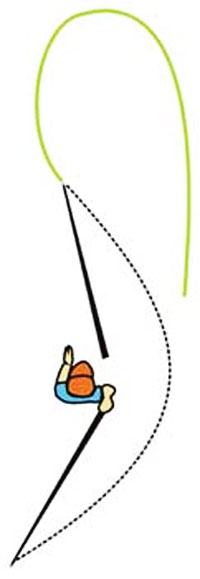Mending Alternative: the Underpowered Cast
Have a question you want answered? Email it to us at [email protected].
Question: The other day, I heard someone talking about using an “underpowered” cast instead of mending. How do you do that?
Robert S., Orinda, CA

This illustration shows an underpowered cast that is mostly overhand, but an underpowered cast can be made from any casting position, including sidearm. Illustration courtesy of Kent Edmonds.
Answer: Sometimes, when you’re fishing in tight quarters or casting across a very fast current, you don’t have the space or time to make a good first mend. (For a discussion of general mending technique, go here.) It helps, in these circumstances, to be able to throw a mend into the cast itself.
The simplest way to do this is to employ a reach cast. As your line rolls out on the presentation cast, point the rod upstream and reach with your casting arm. This causes the line to land at an angle across the current, with the line upstream of the fly. This allows you to achieve a longer dead drift before you need to mend or the line causes the fly to drag. The downside of the reach cast is that it works well only when you have a pretty even current between you and the fly.
When you’re casting from slower water to slower water, with a fast seam between the two, however, you’d like the line to land in a U shape, with the center of the line upstream. One way to achieve this is with an underpowered sidearm cast. What you’re really trying to do is make a “bad” cast work to your advantage. Here’s how to do it:
- Let’s assume a right-handed angler, with the current coming from left to right. So you want your fly to land directly across from you and the center of the fly line upstream.
- Make a sidearm cast with a very open loop.
- On the presentation cast, do not apply a power snap, and allow the rod tip to travel across your body.
- Depending on how far you’re casting, you might not have to stop the rod at all at the end of the cast.
By failing to apply the power snap or stop the rod, you are purposely keeping the line from turning over at the end of the cast. This should cause the line to crash to the water in the intended U shape, as if you’ve already mended.
It takes practice to gauge the right amount of power need to do this right, and this amount will change depending on the distance of the cast, the weight of the fly, and the action of the fly rod. It’s actually easier to make an underpowered cast with a streamer or heavy nymph rig because the weight at the end of the line serves to anchor one end of the U.
To make the same underpowered cast when the current is running right-left, make a back-hand cast, in which you lay the line down on the backcast. Some anglers find this method easier.
The underpowered cast is a great tool to have in your bag. It’s a technique that may look ugly but can be very effective.











